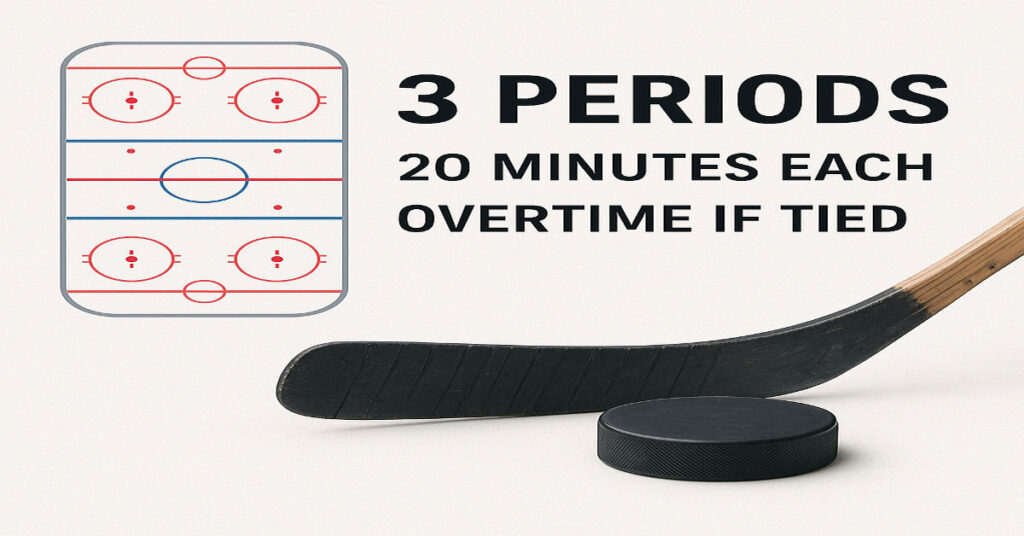Hockey is one of the fastest and most thrilling sports in the world. Whether you are new to the game or a long-time fan, understanding the structure of a hockey game is essential. Unlike sports such as basketball and football, which are divided into halves or quarters, hockey follows a unique three-period system. This article will explore why hockey has three periods, how long each period lasts, what happens during intermissions, and how overtime and shootouts work. By the end of this guide, you will have a complete understanding of hockey’s time structure.
Structure of a Hockey Game
Hockey games at the professional level are divided into three periods. Each period lasts 20 minutes, making the total regulation play time 60 minutes. However, with stoppages, intermissions, and potential overtime, the real-time duration of a hockey game is much longer.
Why Does Hockey Have Three Periods?
Hockey originally followed a two-half format, similar to soccer. However, in the early 1900s, the game switched to three periods for several reasons:
- Improved Ice Maintenance: The playing surface in hockey is ice, which deteriorates over time. Having two intermissions allows arena staff to resurface the ice twice, ensuring better playing conditions.
- Player Fatigue Management: Hockey is a high-intensity sport with quick shifts and heavy physical contact. Dividing the game into three periods allows players to recover during intermissions.
- Game Flow: The three-period structure enhances the pace of the game, making it more engaging for players and spectators.
Length of Each Period
Each period in a standard hockey game is 20 minutes long. However, the clock stops for penalties, goals, and other stoppages, extending the actual length of the game significantly.
- Total Regulation Time: 60 minutes (three 20-minute periods)
- Real-Time Duration: Around 2.5 to 3 hours, including intermissions and stoppages
Intermissions and Their Importance
There are two intermissions in a hockey game, each lasting 15 to 18 minutes. These breaks allow for:
- Ice resurfacing using a Zamboni
- Players to rest and strategize
- Coaches to adjust game plans
- Fans to enjoy entertainment and refreshments
Overtime and Shootouts
If the game is tied at the end of regulation, different leagues have different rules for overtime.
Regular Season Overtime
In most professional leagues, including the NHL, if a game is tied at the end of the third period, a five-minute overtime period is played in a sudden-death format. This means the first team to score wins the game. During regular season overtime:
- Teams play with three skaters and a goalie per side (3-on-3 format), creating more scoring chances.
- If no team scores, the game proceeds to a shootout.
Shootout Rules
- Each team selects three players to take penalty shots.
- The team that scores the most goals after three rounds wins.
- If the score remains tied, sudden-death shootouts continue until one team scores while the other does not.
Playoff Overtime
In the NHL playoffs, overtime is played differently:
- Overtime periods last 20 minutes instead of five.
- There are no shootouts; teams continue playing full 5-on-5 sudden-death periods until a goal is scored.
- This can result in marathon games with multiple overtime periods.
How Hockey Periods Differ Across Leagues
While professional hockey follows a three-period format, other variations exist in different leagues:
International and Olympic Hockey
- Follows the same three-period, 20-minute format as the NHL.
- Overtime rules may differ depending on tournament regulations.
College and High School Hockey
- Games are also divided into three periods.
- Overtime rules vary depending on the governing body.
Recreational and Youth Hockey
- Period lengths are often shorter, typically 12 to 15 minutes per period.
- Some youth leagues use running time instead of stopping the clock for every whistle.
The Impact of Periods on Game Strategy
The three-period format affects how teams strategize:
- First Period: Teams focus on establishing their game plan and testing their opponents.
- Second Period: Considered the toughest due to the long change, where players must skate farther to switch lines.
- Third Period: Teams adjust based on the score, either playing aggressively to catch up or defensively to maintain a lead.
Conclusion
Hockey’s three-period format is unique compared to other sports, but it plays a crucial role in maintaining ice conditions, ensuring player endurance, and keeping the game exciting. Whether you are a player or a fan, understanding the period structure enhances your appreciation of the game. From regular periods to overtime and shootouts, every minute in hockey is filled with intensity and strategy. So, next time you watch a game, you will know exactly what is happening on the ice.
Common Questions About Hockey Periods
Why is hockey played in three periods instead of halves or quarters?
Hockey switched from two halves to three periods to improve ice conditions and reduce player fatigue while enhancing the game’s pace.
Can a hockey game end in a tie?
In professional leagues, no. Regular-season games go to overtime and potentially a shootout to determine a winner. However, some youth and amateur leagues allow ties.
What happens if a goal is scored in overtime?
The game immediately ends, and the team that scored wins.
How long is a hockey game in real-time?
A standard hockey game lasts around 2.5 to 3 hours, factoring in intermissions and stoppages.
Do all levels of hockey follow the same period structure?
Most leagues use three periods, but some youth and amateur levels may have shorter periods or different overtime rules.






